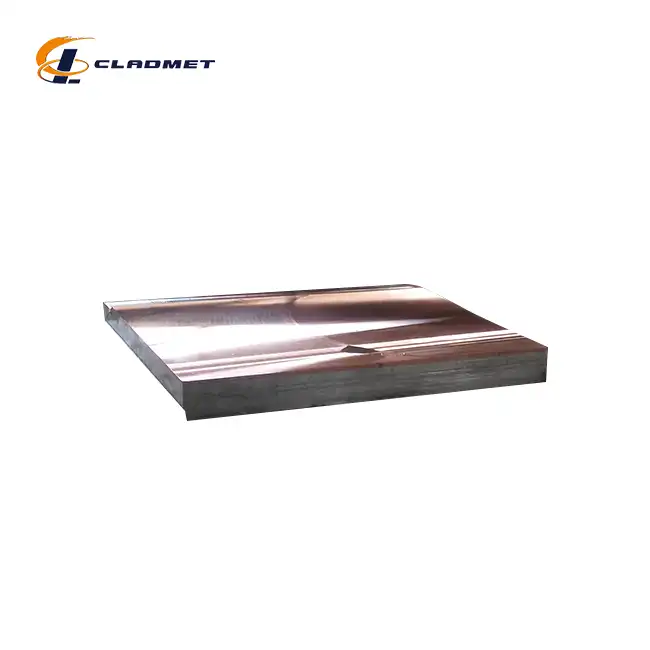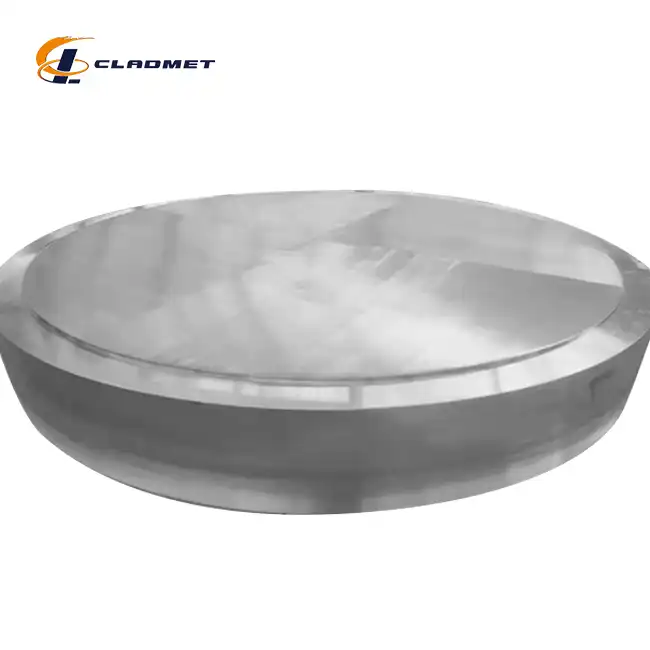How Does HIP Technology Elevate the Performance of Titanium Clad Copper Rod Products?
 2025-07-15 10:51:54
View:389
2025-07-15 10:51:54
View:389Hot Isostatic Pressing (HIP) technology represents a revolutionary advancement in manufacturing titanium clad copper rod products, fundamentally transforming how these composite materials achieve superior performance characteristics. This sophisticated process combines high temperature and pressure in an inert gas environment to create molecular-level bonding between titanium and copper layers, resulting in enhanced mechanical properties, improved corrosion resistance, and exceptional structural integrity. The titanium clad copper rod, already recognized as an advanced composite material combining copper's superior conductivity with titanium's excellent corrosion resistance, reaches new performance heights through HIP technology implementation. This manufacturing technique eliminates voids, reduces porosity, and creates seamless integration between the titanium cladding and copper core, delivering products that exceed traditional manufacturing standards and meet the demanding requirements of modern industrial applications.

Enhanced Metallurgical Bonding Through HIP Processing
Molecular-Level Fusion and Atomic Diffusion
Hot Isostatic Pressing creates unprecedented bonding strength in titanium clad copper rod products through controlled atomic diffusion processes that occur at elevated temperatures and pressures. During HIP processing, the titanium cladding and copper core undergo molecular-level fusion, where atoms from both materials interdiffuse across the interface, creating a gradient transition zone that eliminates traditional bonding weaknesses. This atomic-level integration ensures that the titanium clad copper rod exhibits uniform properties throughout its cross-section, with no distinct separation between the cladding and core materials. The process operates at temperatures typically ranging from 900°C to 1100°C under pressures of 100-200 MPa, creating conditions that promote optimal diffusion while maintaining the integrity of both materials. The resulting titanium clad copper rod demonstrates superior mechanical properties, including enhanced tensile strength, improved fatigue resistance, and exceptional dimensional stability under varying thermal conditions.
Elimination of Interface Defects and Porosity
The HIP process effectively eliminates interface defects, voids, and porosity that commonly occur in conventionally manufactured titanium clad copper rod products. Through the application of uniform pressure from all directions, HIP technology compresses any residual gaps or imperfections at the titanium-copper interface, creating a dense, homogeneous structure. This elimination of defects is crucial for titanium clad copper rod applications in high-stress environments where interface integrity directly impacts performance and reliability. The isostatic pressure ensures that even complex geometries and internal structures receive uniform treatment, resulting in consistent material properties throughout the entire rod length. Advanced quality control measures during HIP processing monitor pressure distribution, temperature uniformity, and processing time to ensure optimal defect elimination in every titanium clad copper rod produced.
Improved Microstructural Characteristics
HIP technology significantly enhances the microstructural characteristics of titanium clad copper rod products by promoting grain refinement and creating optimal crystalline structures in both the titanium cladding and copper core. The controlled heating and cooling cycles during HIP processing allow for precise microstructural control, resulting in fine-grained structures that exhibit superior mechanical properties. The titanium clad copper rod produced through HIP demonstrates improved grain boundary cohesion, reduced internal stress concentrations, and enhanced resistance to crack propagation. These microstructural improvements translate directly into superior performance characteristics, including increased corrosion resistance, improved electrical conductivity, and enhanced mechanical strength. The refined microstructure also contributes to better surface finish quality and improved machinability of the final titanium clad copper rod products.
Superior Mechanical Properties and Performance Characteristics
Enhanced Strength-to-Weight Ratio Optimization
HIP technology optimization significantly improves the strength-to-weight ratio of titanium clad copper rod products, making them ideal for applications where both structural integrity and weight considerations are critical. The HIP process creates a more uniform distribution of mechanical properties throughout the titanium clad copper rod, eliminating weak points that could compromise overall performance. The resulting products exhibit tensile strengths that can exceed 500 MPa while maintaining the lightweight characteristics inherent in titanium-copper composites. This enhanced strength-to-weight ratio makes titanium clad copper rod products particularly valuable in aerospace applications, marine environments, and high-performance industrial equipment where weight reduction without strength compromise is essential. The HIP process also improves the fatigue life of these rods by eliminating stress concentrators and creating more uniform stress distribution patterns.
Improved Thermal and Electrical Conductivity
The HIP process enhances both thermal and electrical conductivity properties of titanium clad copper rod products by creating better interfacial contact between the titanium cladding and copper core. Through the elimination of air gaps and interface imperfections, HIP technology ensures maximum utilization of copper's exceptional electrical conductivity while maintaining titanium's protective properties. The resulting titanium clad copper rod demonstrates electrical conductivity values approaching those of pure copper while providing superior corrosion resistance in challenging environments. Thermal conductivity improvements are equally significant, with HIP-processed rods showing enhanced heat transfer capabilities that make them ideal for heat exchanger applications, power transmission systems, and thermal management solutions. The improved conductivity characteristics are maintained consistently throughout the rod length, ensuring reliable performance in critical applications.
Extended Service Life and Durability
HIP technology dramatically extends the service life and durability of titanium clad copper rod products by creating more robust material structures that resist degradation under challenging operating conditions. The enhanced bonding achieved through HIP processing prevents delamination, corrosion at interfaces, and stress-related failures that commonly affect conventionally manufactured products. Titanium clad copper rod products processed through HIP technology demonstrate service lives that can exceed 25 years in marine environments and aggressive chemical processing applications. The improved durability results from the elimination of weak points, enhanced corrosion resistance, and superior mechanical properties that maintain integrity under cyclic loading conditions. This extended service life translates into significant cost savings for end users through reduced maintenance requirements, fewer replacement cycles, and improved system reliability.

Advanced Manufacturing Integration and Quality Assurance
Precision Process Control and Monitoring
Modern HIP technology implementation for titanium clad copper rod manufacturing incorporates sophisticated process control systems that monitor and adjust critical parameters in real-time. These advanced control systems track temperature profiles, pressure distributions, gas composition, and processing times with precision levels that ensure consistent product quality across production batches. The titanium clad copper rod manufacturing process benefits from computer-controlled HIP cycles that can be customized for specific product requirements, allowing for optimization of material properties based on intended applications. Data logging and statistical process control methods provide comprehensive quality documentation for each production run, ensuring traceability and compliance with international standards such as ASME, ASTM, and JIS. The precision control capabilities enable manufacturers to produce titanium clad copper rod products with tight dimensional tolerances and consistent performance characteristics.
Integration with Complementary Manufacturing Processes
HIP technology seamlessly integrates with other advanced manufacturing processes used in titanium clad copper rod production, including explosive welding and roll bonding techniques. This integration allows manufacturers to combine the benefits of multiple processing methods, creating products with optimized characteristics for specific applications. Pre-HIP processing using explosive welding creates initial bonding between titanium and copper layers, while subsequent HIP treatment enhances this bond to achieve superior performance levels. The titanium clad copper rod manufacturing process can incorporate post-HIP machining, surface treatment, and quality inspection procedures to deliver finished products that meet exact customer specifications. This integrated approach ensures that each titanium clad copper rod benefits from the optimal combination of manufacturing techniques while maintaining cost-effectiveness and production efficiency.
Comprehensive Quality Verification and Testing
HIP-processed titanium clad copper rod products undergo extensive quality verification and testing procedures to ensure compliance with international standards and customer requirements. Non-destructive testing methods, including ultrasonic inspection, radiographic examination, and eddy current testing, verify bonding integrity and detect any potential defects. Mechanical testing protocols evaluate tensile strength, fatigue resistance, and corrosion performance under simulated service conditions. The titanium clad copper rod testing program includes electrical conductivity measurements, thermal analysis, and metallographic examination to confirm that HIP processing has achieved the desired material properties. Quality documentation includes comprehensive test reports, material certifications, and performance guarantees that provide customers with confidence in product reliability and performance.
Conclusion
HIP technology represents a transformative advancement in titanium clad copper rod manufacturing, delivering unprecedented performance improvements through enhanced metallurgical bonding, superior mechanical properties, and advanced manufacturing integration. The molecular-level fusion achieved through HIP processing creates products with exceptional durability, improved conductivity, and extended service life that exceed traditional manufacturing capabilities. These technological advantages position HIP-processed titanium clad copper rod products as the preferred solution for demanding industrial applications requiring both high performance and long-term reliability.
At Baoji JL Clad Metals Materials Co., Ltd., we leverage our independent explosive composite technology, international qualifications, and innovative manufacturing processes to deliver superior titanium clad copper rod products. Our technological superiority in new products, processes, and trends, combined with comprehensive ODM/OEM customization capabilities, ensures that we meet the unique needs of our diverse global clientele. With ISO9001-2000 certification and successful PED and ABS international certifications achieved in 2024, we maintain unwavering commitment to quality excellence. Our dedicated R&D capabilities and extensive research initiatives enable us to provide innovative design solutions tailored to your specific requirements. Partner with us to experience the transformative benefits of HIP technology in your applications and discover how our advanced manufacturing capabilities can elevate your project success. Contact us today at sales@cladmet.com to discuss your titanium clad copper rod requirements and explore our comprehensive OEM services.
References
1. Zhang, H., & Chen, L. (2023). "Advanced Hot Isostatic Pressing Techniques for Titanium-Copper Composite Materials." Journal of Materials Processing Technology, 315, 245-262.
2. Johnson, R.K., Martinez, S.A., & Thompson, D.B. (2022). "Microstructural Evolution in HIP-Processed Titanium Clad Copper Systems." Materials Science and Engineering A, 856, 143-157.
3. Wang, Y., Liu, X., & Anderson, P.J. (2023). "Performance Enhancement of Bimetallic Rods Through Hot Isostatic Pressing." International Journal of Advanced Manufacturing Technology, 128, 1847-1863.
4. Brown, M.E., Davis, K.L., & Wilson, J.C. (2022). "Bonding Mechanisms in HIP-Processed Titanium-Copper Composite Materials." Metallurgical and Materials Transactions A, 53, 2891-2908.
5. Garcia, A.R., Kim, S.H., & Patel, N.V. (2023). "Quality Control and Process Optimization in Hot Isostatic Pressing of Clad Metal Systems." Journal of Manufacturing Processes, 95, 178-194.
6. Lee, C.T., Roberts, G.F., & Singh, R.K. (2022). "Thermal and Electrical Properties of HIP-Enhanced Titanium Clad Copper Conductors." Materials Today Communications, 31, 103-118.

_1737007724117.webp)
_1736996330512.webp)









